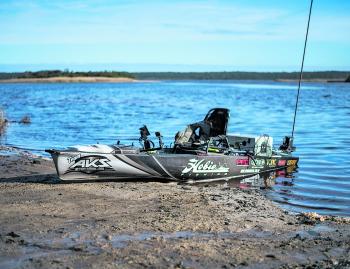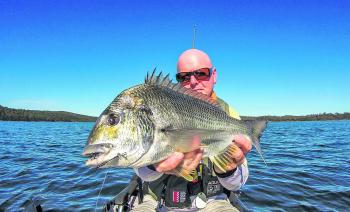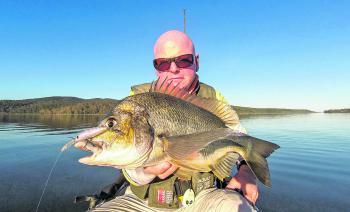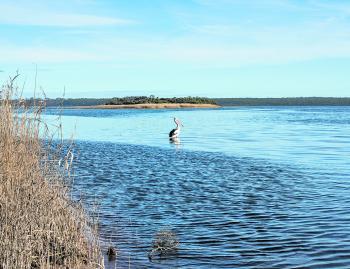Ever heard the old phrase “do the miles, get the smiles”? It’s a simple sentiment that rings very true, particularly in relation to kayak angling. It often seems the further I travel off the beaten track, the better the fishing experience waiting for me at the end of the road is.
Exploring our remote Victorian estuaries in my kayak has been an absolute highlight for me over the past few years and Tamboon Inlet would be the one remote system that stands out at the top of that highlights reel.
Located in the far east of the state, Tamboon Inlet is often overlooked by anglers travelling east as they focus on more well known destinations nearby such as Mallacoota Inlet, Marlo and Bemm River. Offering trophy size bream and estuary perch as well as monster dusky flathead and a menagerie of other estuary species, it is well worth the effort of spending a few days camping on the banks to find out firsthand what this truly remarkable angling destination has to offer.
Access to the inlet is gained by turning off the Princess Highway at Cann River and heading south for approximately 30 minutes along Tamboon Road and then onto Fishermans Track.
There are two launch options, the first being at Funnell Landing, which is located further up the river, the second and my preferred launch site is at Peachtree Creek Reserve, which gives more direct access to the inlet itself.
At almost six hours from Melbourne, it’s a long drive, and due to the long travel times to Tamboon I like to make a weekend of it and camp. Peachtree Creek has 11 unpowered campsites available, with facilities that include non-flush toilets, fireplaces, jetty and a gravel ramp. If you need access to a powered site to charge batteries, then Cann River Rainforest Caravan Park is a great option.
As with all the systems in our state’s far east, a vast range of target species are available to anglers fishing Tamboon Inlet. Dusky flathead are plentiful and best targeted when the water warms from early spring to late autumn.
Estuary perch can be found in the lake during late winter as they make their way towards the mouth to spawn. Other times of the year perch will spread out and move higher in the system.
Bream are a reliable option all year round. During the winter months they can be found in the deeper sections of the lake schooled up, and as the water warms bream move to the edges and flats.
Other species on offer at Tamboon include tailor, silver trevally, Australian salmon, luderick and mullet.
One of the standout features at Tamboon are the extensive flats that line the banks of the lake. These areas are always the first spot on my list when I fish there during the warmer months. Flathead, bream and perch will move into the warm shallows to feed on the abundance of bait available.
My prefered method of tempting fish on the flats is to cast lures up into the shallows and work them back with a twitch and pause style retrieve. I like to keep my lure in contact with the bottom as much as possible, so therefore choose lures appropriate to the depth of the flat you are fishing.
Using an erratic retrieve will cause the lure to ‘dig’ down into the sandy bottom producing a puff of sand as it does so, and it is this action that often fires up the fish. Crankbaits are a proven performer on the flats, however I always find longer profile minnows or jerkbaits produce better at Tamboon. Lures such as Jackall Chubbies, Daiwa Spikes and the Strike Pro Bass-X are excellent in water 1-2m deep, but if casting into water less than a meter I like Daiwa Double Clutch 60s.
Another productive technique on the flats at Tamboon, particularly after a warm night with low winds is to work surface lures across the flats. Bent minnow style lures can be killer, and long casts fired out over the flat and then worked back using a double twitch pause retrieve often attracts plenty of interest.
The edge bite at Tamboon can be excellent. The edges of the lake are mainly made up of shallow sand flats where the techniques mentioned above are the best way to entice a hungry bream or opportunistic flathead. There are a few rocky points and snag-laden edges where a variety of different techniques will produce a bite. Soft plastic grubs cast up tight against rock edges or fallen timber and slowly twitched down the drop offs can be dynamite when conditions are right.
As previously mentioned, estuary perch will move into the lower reaches of the lake during the cooler months as they prepare to spawn. When chasing perch, I like to employ a more constant retrieve and select lures that will remain higher in the water column.
Bream will form huge schools and move into deeper sections of the lake during winter as they too prepare to spawn. Use your sounder to locate the schools and cast metal blades or vibes into the schools. Plastics rigged on slightly heavier jigheads around 1/12oz can also be a great way to target these schooling fish.
Due to Tamboon’s relative remoteness, mobile phone reception can be very limited and it is well advised to inform a family member of your plans before traveling, particularly if you’re flying solo. As always, remember to wear your PFD and keep a bailer on board as required by Victorian law.
Tamboon Inlet is an absolutely magnificent fishery set within the boundaries of the Croajingolong National Park. Untouched forest, towering sand dunes and majestic rock formations surround the estuary creating a truly breathtaking backdrop combined with some of the best estuary fishing in the state, so the idea of spending a weekend at Tamboon shouldn’t be too hard to swallow.
Reads: 5114
Peachtree Creek Reserve offers excellent camping and launch options with direct access to Tamboon Inlet.

This trophy sized EP was caught during a cold, wet and windy winter’s day on a Strike Pro Bass-X.

An excellent yellowfin bream taken from a sharp drop off on a Strike Pro Cyber Vibe.

Tamboon’s reputation of producing giants is well deserved. This 46cm brute smashed a Daiwa Spike worked erratically across a shallow flat.

Tamboon Inlet is an absolutely magnificent fishery surrounded by the breathtaking CroajingolongNational Park.




